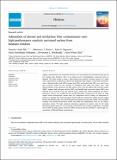| dc.description.abstract | Organic contaminants from wastewater toxicity to the environment has increased during the last few decades and, therefore, there is an urgent need to decontaminate wastewater prior to disposal. This study aimed to create a high surface area catalytic activated carbon (AC) under same carbonization conditions for phenol and methylene blue (organic wastewater) decontamination. Moringa oleifera husk (MH), sesame husk (SH), and baobab husk (BH) were used to prepare activated carbon for the removal of methylene blue (MB) and phenol (Ph). After characterization of the adsorbent, the BET surface areas of the M. oleifera husk activated carbon (MHC), sesame husk activated carbon (SHC), and baobab husk activated carbon (BHC) were 1902.30 m2/g, 1115.90 m2/g, and 1412.40 m2/g, respectively. Mono-adsorption and binary-adsorption systems were studied for Ph and MB adsorption. Furthermore, the effect of initial organic waste concentration, contact time, pH, temperature and AC dosage, on adsorption capacity were studied. The mono adsorption system isotherms and kinetics studies used to analyze Phenol and MB adsorption best fitted Langmuir and pseudo-second-order models. The Freundlich isotherm and pseudo-second-order model best fitted the experimental data for the binary-adsorption system. The high maximum adsorption capacities of organic waste for the single and binary systems were 352.25–855.96 mg/g and 348.90–456.39 mg/g, respectively. The results showed that the high surface activated carbon produced had the potential to adsorb high concentrations of MB and Phenol contaminants. | en_US |

